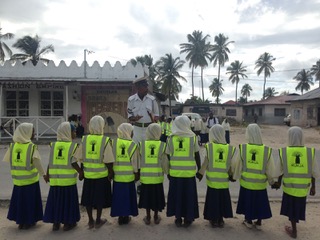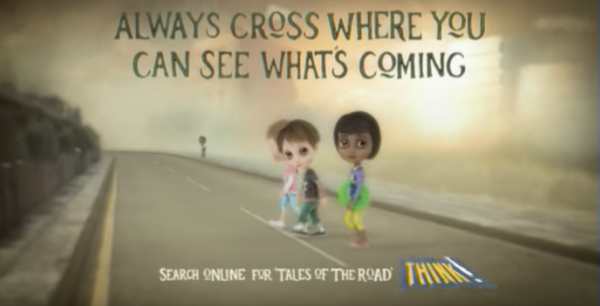
Education
Look left; look right—look right; look left…look left again…before you cross the street.
Road Safety song taught to children
Educating children about how to safely interact with streets is critical for improving their health and mobility. This may include instruction on obeying road markings and street signs, using public transport, and following safe walking and cycling practices. Education programs can also highlight the benefits of active lifestyles and the need for regular physical activity.
5 KEY LESSONS
1. Experiment
Combine several teaching practices such as play-based activities, use of songs, repetition, and role playing.
2. Learn from examples
Start early (ages 4-5), support individual, incremental training methods, and harness behavior-based training over classroom instruction.
3. Build awareness and confidence
Use voluntary cycle license campaigns to promote awareness and create a culture of active transport and independent mobility.
4. Create video content
Animated characters, training/parable songs, and brief evocative accounts are especially powerful techniques in communicating with children.
5. Don’t forget the role that private vehicles play
Safe driving promotions for motor vehicle users reduce traffic violence.
Best practices
Consider experimenting with a variety of creative and interactive techniques and tools such as play-mat models, board games, and illustrated posters. Computer-supported practical training comprised of small groups of children interacting with each other is also effective in teaching traffic rules and common scenarios. Road safety education can start as early as ages 4-5 and can continue through primary and secondary school.
Case Study: Safe Walks Program
Kukua Community Projects in East Africa was founded in the Zanzibar village of Jambiani by a group of teachers and social workers in response to the alarming rate of traffic-related injuries and fatalities of children in the area. Kukua means “to grow” in Swahili and is based on the firm conviction that no child should ever have to risk his or her life simply to attend school.
In partnership with the traffic police, Kukua provides Safe Walks, a program created by education experts using evidence-based research to offer practical and behavioral training adapted to the local environment. The program is designed for children as young as five years old in rural and urban areas, where schools are often located at the foot of high-speed roads and the majority of children either walk or cycle to school.
Kukua provides training and didactic materials and empowers teachers to deliver vital knowledge. Safe Walks draws from a variety of teaching methods, ranging from real-life street crossings supervised by the traffic police to educational games, visual exercises, role play, and songs in Swahili. Another powerful part of the program is Richard Mabala’s humorous yet instructive book, which tells the story of Rama, a naughty 7 year-old from Zanzibar who is almost hit by a car when playing on the road.
Teachers involved in the 2017 pilot project have demonstrated their ability to successfully teach Safe Walks to their pupils and are now learning methods to help children develop alternative and safer routes to school. The program is now being expanded throughout the island and to mainland Tanzania.
The Safe Walks program has also extended beyond the classroom to ensure a more safe and accessible journey to school, working with parents, community members and the government to raise public awareness and bolster public capacity for improving driving habits, road safety policy, and infrastructure. Kukua mobilizes the community and builds consensus to advocate and propose local solutions within government mobility and development projects to create public spaces and roads that are safe and accessible to children.

Case Study: Tales of the Road
The United Kingdom’s “Tales of the road” campaign is an example of educating children about the rules of the road through storytelling rather than regulation. Launched in November 2008, it follows a long tradition of successful road safety campaigns by the Department of Transport. The campaign features educational guides, targeted activities, worksheets, animated characters, and short video episodes to introduce effective road safety practices to children. While the campaign is aimed at 6 to 11 year olds, the road safety messages it presents are relevant to children of all ages. The campaign adopts results of extensive research on the most effective ways to communicate with children.

Case Study: BRAC road safety education
The Government of Bangladesh, the World Bank, and BRAC (known formerly as the Bangladesh Rural Advancement Committee) collaborated to support a pilot community-based road safety program that ran from May 2015 through December 2016. Headmasters of selected schools (within 500 meters of a road within the project area) were given a day-long training on road safety. Using a consistent set of educational activities and media, including flip charts, quiz books, and video shows, students were taught road safety messages, such as “Follow the traffic signs,” “Do not play or chat on the road,” and “Do not get in or down from a moving bus.” Through the course of the 19 month program, the road safety education program was implemented at 135 schools to over 53,000 students. Post-program assessment indicated that the students could recall 87 per cent of the program messages.
Adult-led learning and peer collaboration are powerful instruments because of the influence of social interaction on learning, and the tendency to model behavior. An example for youth mobility training is training all students in a class to ride bicycles, and follow the rules of the road. As in the Netherlands Cycling Exam case study (below), this may “social proof” the idea of bicycling as a normal and accepted form of transport.
Case Study: Dutch children’s Cycling Exam
The Netherlands is a small and flat country whose entire transport system is built around bicycles. Following years of significant investment in infrastructure and supportive policies, over 70 per cent of the population use a bike in their daily routines.
Around the age of 4 it is expected that Dutch children learn how to ride a bike. School children are trained in schools to ride their bicycles and then given a written multiple-choice test to assess their understanding of traffic rules. An on-bike traffic test then takes children through 6 km of normal traffic and different situations that they may encounter on a daily route. Those who successfully complete the written and practical exams are issued a cycling license. This typically happens by age 12 before the transition to secondary school. This initiative hopes that educating children about safe cycling rules and behaviors will increase their mobility and decrease the number of road crashes. Some of guidance provided as part of the training is listed below:
First find the safest place to cross.
Stop just before you get to the edge of the pavement.
Look all around for traffic and listen.
If traffic is coming, let it pass.
When it is safe, go straight across the road—do not run.
A traffic garden is a miniature street network where children learn about roadways and safety. They have fun crossing streets or riding bikes and driving pedal cars, all in a vehicle-free environment. Learning happens during active play and social interactions as well as through adult instruction.
